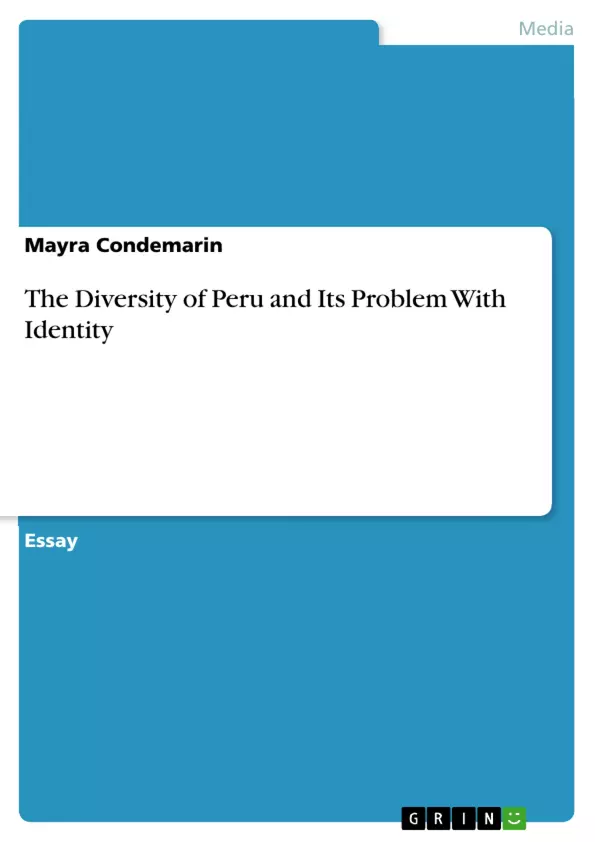Peru is a rich country - not in the economical sense, because even if it is today “one of the best performing economies in Latin America“ (World Bank, 2012), Peru still suffers from poverty, hunger, and ethnic conflicts as many countries in Latin America do. The focus lies here more on the country‘s richness based on history, nature, climate and cultural life.
Peru is a country in western South America and borders on Ecuador and Columbia in the north, Brazil in the east, Bolivia in the southeast and Chile in the south. The world‘s driest desert, the Atacama desert, is located in the south of Peru to the boarders of Chile. What distinguished Peru from other countries in South America is the division of the country into three different biomes: The Costa (coastline) in the west of the country bordering the South Pacific Ocean; the Sierra, with the high and rough Andes in the centre; and the Selva, the eastern lowland jungle of Amazon Basin. The capital of Peru is Lima and lies in the Costa region.
With its coastline which is approximately 2,000 kilometres long (longest in the world) and innumerable beaches, unique flora and fauna, climate from tropical to dry desert, historical pre-Hispanic places like the Inca site Machu Picchu, and the multicultural capital, Peru is a very diverse country. Not only geographically, but also when it comes to its population and cultural life. Peru is an indigenous country, which means that the majority of the population consist of so called amerindios or indios, and define the pre-Hispanic citizens of Latin America. 37 percent are mestizos, which describes the mixture of white, black and asiatic people with the amerindios due to colonization and immigration.
What stands out is the white minority which makes today only 15 percent of the Peruvian population. Three percent are, because of large immigration during the 1970s and 1980s, Japanese or Chinese Peruvians. Undoubtedly, the mixture of different ethnic groups defines what is today the Peruvian culture and national identity. However, there are still problems among Peruvians which can be noticed in terms of the acceptance of the own identity.
Table of Contents
- The Problem with Peru's Identity
- Lack of Acceptance
- When the Spanish came
- How the Past still lives on
Objectives and Key Themes
This essay explores the complexities of Peruvian identity, focusing on the challenges posed by historical factors and the persistence of ethnic discrimination. It examines the ongoing struggle to reconcile a proud national identity with the realities of a diverse and often marginalized population.
- The impact of Spanish colonization on Peruvian culture and identity
- The persistence of ethnic discrimination against the indigenous population
- The role of patriotism and national pride in shaping Peruvian identity
- The challenges of defining a unified Peruvian identity in a diverse society
- The significance of indigenous traditions and beliefs in contemporary Peru
Chapter Summaries
The first chapter, "Lack of Acceptance," introduces the essay's central theme by exploring the author's personal experiences with Peruvian identity and the prevalence of ethnic discrimination within the country. The chapter highlights the challenges of defining a Peruvian identity in a society where ethnic divisions persist.
The second chapter, "When the Spanish came," delves into the history of Spanish colonization in Peru and its lasting impact on the country's culture and identity. It examines the conquest of the Inca Empire, the introduction of Catholicism, and the challenges faced by the indigenous population during this period.
The third chapter, "How the Past still lives on," explores the ways in which pre-Hispanic traditions and beliefs have survived despite the influence of Spanish colonization. It highlights the importance of indigenous culture in shaping contemporary Peruvian identity.
Keywords
The essay focuses on the themes of Peruvian identity, ethnic discrimination, Spanish colonization, indigenous culture, and national pride. Key concepts explored include the challenges of defining a unified identity in a diverse society, the persistence of historical legacies, and the role of cultural preservation in shaping national identity.
- Citation du texte
- Mayra Condemarin (Auteur), 2013, The Diversity of Peru and Its Problem With Identity, Munich, GRIN Verlag, https://www.grin.com/document/300130



